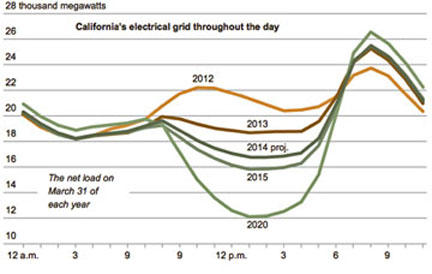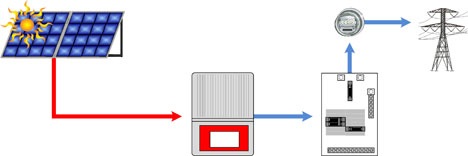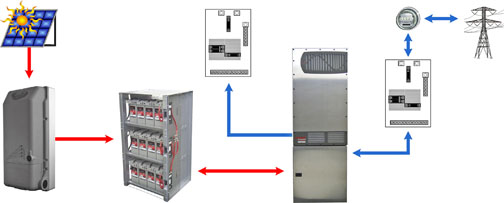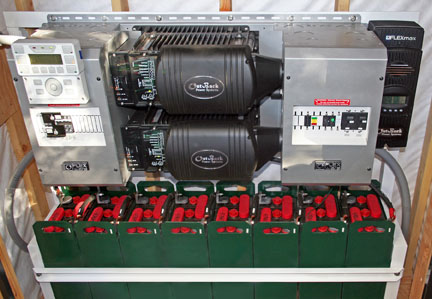Many industry experts will tell us that if we smarten up our utility grid with digital technology, it will become more reliable, resilient, flexible and efficient. While that may be true, what problem will the smart grid solve if there’s no way to store energy? Before we go too deep into that question, let’s take a look at the capacity and peak demand problems plaguing many utilities today.
The duck’s back
The push for renewable energy as a way to add more carbon-free electrical capacity has exacerbated the peak demand problem, especially when it comes to solar, which typically produces power when it is needed least. With the price
The electrical grid in sunny California clearly illustrates the impact of solar power’s growth on the peak demand problem. Figure 1 shows the electrical demand curve on a typical California weekday from midnight one day to midnight the next. The biggest peak of the day starts around 4:00 pm, when family members start arriving home from school and work. The demand grows in the early evening hours, as lights, dishwashers and entertainment systems turn on and consume even more power from the grid.

Figure 1: Typical 24 hour power demand curve.
The response curve in Figure 1 has been described as a Duck’s back. As you can see, the peak solar generation period, from about 10:00 a.m. to 4:00 p.m. occurs when the utility needs it the least. Whether the energy is being self-consumed or dumped onto the grid, the curve of the duck’s back will grow steeper as projected additional solar comes online each year.
Looking out to 2020, the 4:00 to 9:00 p.m. peak demand will continue to grow, while the mid-day will be filled by solar. One option here is to add more transmission and distribution lines, as well as more and larger substations, but these are costly solutions and would require new “peaking generation plants” to meet that demand. Plus, just having an efficient and response smart grid still doesn’t solve the problem of what to do about that increasing arch of the duck’s back. Most peaking plants are steam turbine-based generators, whether powered by coal, natural gas or nuclear power; these are inherently slow coming online and must be powered up well before needed as “spinning reserve.”
Distributed storage
What about a smarter way to tackle the peak demand issue and make the smart grid more viable? Many believe that some form of on-demand stored energy is required to stockpile energy when available and deploy it when needed most, eliminating the need for wasteful and sluggish spinning reserves. Storing energy at the distributed level, where it is both generated and consumed at the point of use, will eliminate the need for costly expansions of the transmission and distribution lines as well as substations. Generating electricity via solar could do away with a lot of the need for a smart grid and other expensive infrastructure costs.
Storage is the key to distributed generation. The energy storage system must be delivered in a smart way to offer the most benefit to both the electrical utility provider and the home or business owner.

Figure 2: Battery-less grid tie inverter.
About 90% of solar installations in North America use “grid-tie” inverters (no batteries) that convert DC power from the solar array to AC power, which is consumed locally or exported to the grid when solar generation exceeds the local power demand. A typical grid tie inverter connection is illustrated in Figure 2. The concept being that the grid acts as the battery – by accepting solar power when there is excess production, and giving it back when the sun is no longer shining. As stated earlier, the problem with this concept is that the give and take of the solar power is happening at the wrong times.

Figure 3: Battery-based grid-hybrid inverter.
A battery-based inverter system is shown in Figure 3. A DC-to-DC converter from the PV array can charge the battery directly; send DC power directly to the inverter to power the critical load center; send energy to the mains panel for additional self-consumption; or, if solar production exceeds total load demand, export excess power to the grid just like the battery-less grid-tied inverter. If necessary, grid power can also be used to charge the batteries. This type of battery-based inverter that can provide both backup power and interact with the grid is sometimes referred to as a grid-hybrid inverter.
Both the grid-tie inverter and grid-hybrid inverter can push excess power out to the grid once the site’s electrical demand has been met. In some utility districts, the home or business can qualify for feed-in tariff (FIT) rebates or credits for the renewable energy that is generated. In some cases, the revenue meter that measures power usage will slow down or spin backwards, essentially providing a credit or “net metering.”
Some grid-hybrid inverters have grid connection timers that automatically connect and disconnect from the utility grid up to three times per day on weekdays, and once per day on weekends. This allows utility customers to temporarily disconnect from the grid and use the stored energy in the batteries during expensive time-of-use surcharge periods, such as the 4:00 to 9:00 p.m. peak demand period, which leads to significant savings on utility bills.
The same class of equipment has another feature referred to as a support mode in that the incoming power can be limited with the balance of power coming from the battery bank. For example, if the incoming utility current limit is set to 15 amps and the electrical load in the house increases to 25 amps, then 10 amps from the battery bank would be “blended” with the 15 amps of utility power to satisfy the 25 amp load demand. This feature keeps the peak demand below a certain level, as some utilities have a peak demand charge on top of time-of-use charges. The peak demand is often the highest 15-minute period during a month’s power use. That one 15-minute demand period charge can be an even higher percentage of the monthly utility bill than the total metered usage charge.
There is another self-consumption feature besides the grid use timers that can “zero out” the grid. This feature was developed in response to utilities that were denying connection agreements to their customers with battery-based inverters. This denial was mostly due to a lack of understanding of how battery-based inverters work and their actual benefit to the utility. The objective of a grid-zero mode is to minimize power from the grid and maximize solar power self-consumption. It does this by limiting the discharge rate from the batteries to the loads, and only when that limit is exceeded does the inverter draw power from the grid. Grid-zero is therefore blending utility power with solar power, but only when load demand exceeds user-selectable limits. This function will never charge batteries from the utility, which was another misconception among utilities.
While industry experts and media love to talk about smart grid benefits, the fact is that many of those features may still be a long way off. There’s no need to sit and wait when there are smart grid features with advanced battery-based inverters that can reduce utility bills today. Not only will these features help reduce costs, they’ll better position utilities to address the duck’s back demand and expand infrastructure.
Grid-hybrid inverter batteries
There are two important factors when considering batteries for daily charging and discharging to support this type of application: cycle life and capacity. The cycle life of lead acid batteries can vary significantly and is dependent on how deep the batteries are discharged. For example, OutBack Power has sealed lead acid batteries rated at 1800 cycles at 50 % depth of discharge, or 3,000 cycles at 30 percent DOD, which translates to about 5 years or 8 years of life, respectively. Many lithium ion batteries have the same or higher cycle life at deeper discharges. While the lithium ion battery seems to be the best choice with regards to cycle life, they are also significantly more expensive.

Figure 4: An OutBack Power grid-hybrid inverter system.
Deciding on battery involves figuring the kWh required for your site and the portion of the battery that you will use on a daily basis, e.g. the %DOD. With the required battery bank estimated, you can see sizes for the different cycle life/capacity ratings and price out different battery banks available – working through the tradeoffs off of cycle life, size, capacity, and cost.
Advertisement
Learn more about OutBack Power





